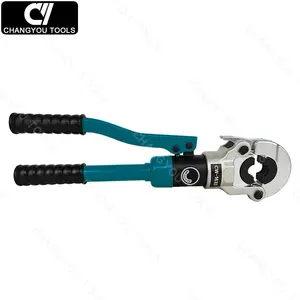
Hoston 38CNC-2A New High Quality Flat Iron Hoop Bending Machine Pipe Clip Making Machine Special-shaped Bending Machine


RJ45 Crimping Tool For Cat3 Cat5e Cat6 EZ Cat7 Modular Plug Pass Through Type























A pipe crimping tool is a mechanical device used for securely joining pipes through a compression process. When the mechanism is activated, the crimper's sturdy steel jaws compress the pipe, pressing it firmly into the fitting. This action mechanically forms a tamper-proof connection without any adhesives, soldering, or welding required. Crimping tools are designed to work with specific pipe sizes, from small-diameter tubing to larger pipes. They come in variants like the copper pipe crimping tool and the steel pipe crimping tool. You can opt for manual ratcheting crimpers, electric-powered crimpers, or hydraulic pipe crimping tools based on your preference. Powered crimpers allow for rapid connection of pipes in the field or on industrial projects. Whichever style is used, the tool precisely forms the compressed fitting-pipe joint.
When using a pipe crimping tool, the first step is to insert the prepared pipe end fully into the fitting. The fitting will typically have barbs, ridges, or a flared opening to hold the pipe securely in place but allow for expansion during crimping. Next, position the assembly between the open jaws of the crimping tool so the pipe and fitting are centered. For powered tools, this engages the motor or hydraulic system. On manual crimpers, like the water pipe crimping tool, the user begins ratcheting or squeezing the handle. As the handles or mechanism close the jaws, their specially profiled inner surfaces start compressing the pipe and fitting in multiple stages. The pipe material is pushed radially outward while also being indented by the ridges inside the jaws. This causes the pipe to expand and press tightly against the fitting's interior ridges or collar. As the jaws progressively squeeze further closed, they'll leave indent ring marks on the finished crimp. This "rollover" effect thoroughly works the pipe material to form a leak-proof seal within the fitting. Once fully crimped, the jaws are opened, and the tool can be removed, revealing the completed compression joint.
Crimping allows fittings to be attached much faster than soldering or welding joints. This improves installation efficiency and reduces labor costs on jobs. When done correctly, crimped pipe connections provide leak-proof reliability equal to or better than other joining methods. They hold up very well to vibration stresses and pressure cycling over many years. By avoiding open flames and high heat, crimping protects users from burn risks associated with soldering. It also removes fire hazards compared to welding pipes. This makes the process safer for indoor use. Should a connection need to be undone someday, crimped pipes are undamaged and reusable. Only the inexpensive fitting needs replacement for a new joint. Major plumbing codes now accept crimped joints for applications like potable water lines. This approval expands design options that can speed project approval. The compression joint formed is stiff and resilient, protecting against impacts that could compromise other soft joint types. It withstands weathering effects outside, too.